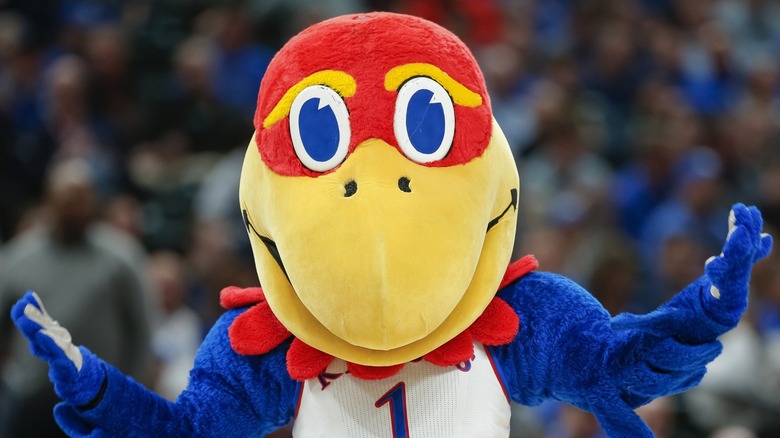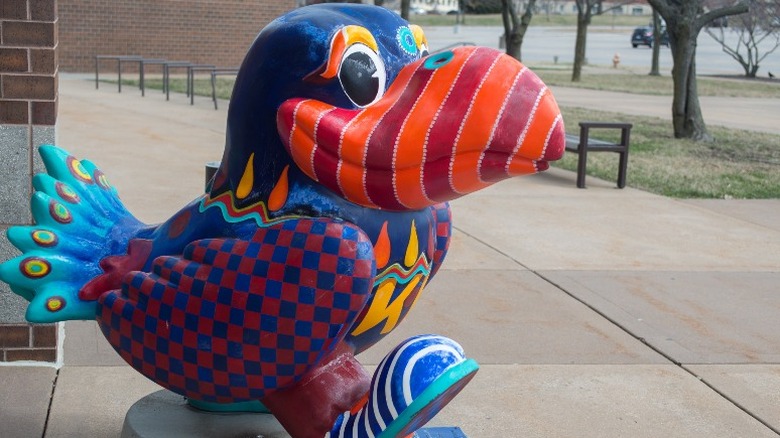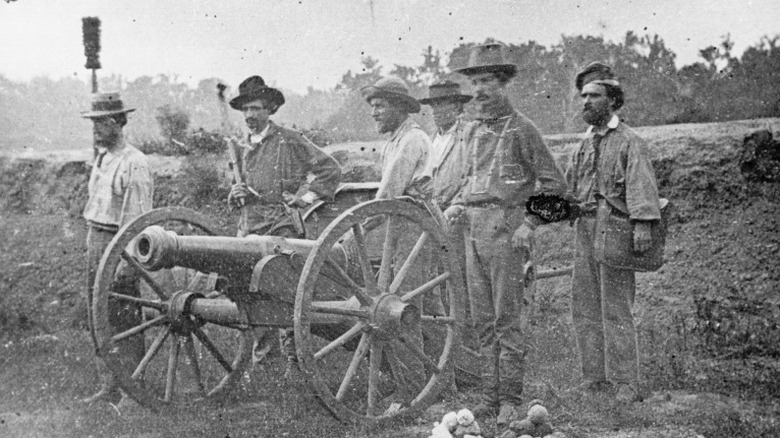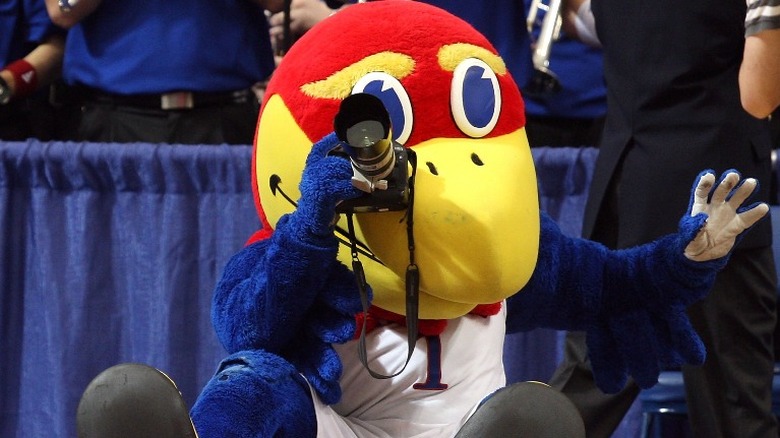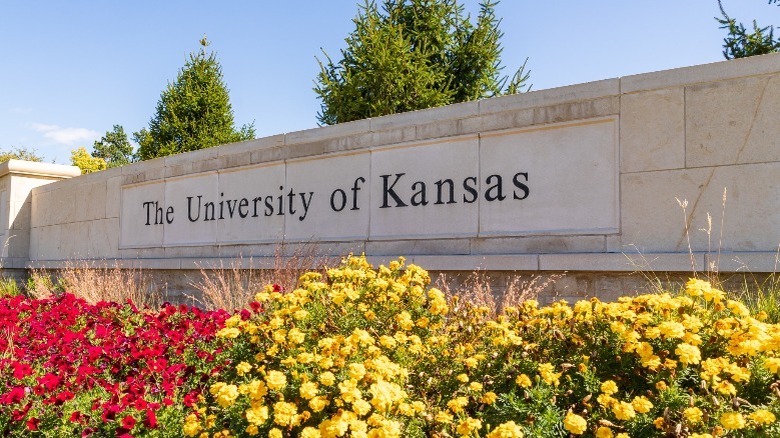The Origin Of The University Of Kansas Jayhawk Explained
The mascots that appear on university logos are sometimes more than just costumed characters that help rally fans from the sidelines. They help tie together a group of fans with school spirit and move to get the crowd behind the home team. Whether a Cornhusker, a Blue Devil, or a Bulldog, you can be sure that the alumni of each school can probably describe in detail their alma mater's most well-known character and can maybe hum a few bars of their fight song.
Some mascots are linked to significant events in our nation's history. And after reading this article, you'll see that the University of Kansas Jayhawk is more than just a cartoonish character based on a mythical bird. While it might be hard to imagine it while someone dressed as the Jayhawk is stirring up team spirit during university basketball games, the Jayhawk itself is based on a storied group of people from the old Kansas Territory that helped change the course of history.
The history of the Jayhawk
According to the University of Kansas, the Jayhawk was never a real species of bird. The Jayhawk was probably created by combining two species of bird that are local to the northeast part of Kansas where the university lies: the sparrow hawk and the blue jay. But the Jayhawk wasn't always the lone mascot for this university. KU had a bulldog that was used alongside the Jayhawk until 1958 when the bulldog was retired, and the Jayhawk become officially the lone mascot to represent the school.
Even though the University students were known as "Jayhawks" or "Jayhawkers," there was no actual depiction of the bird for the first few decades of the school's existence. In fact, it wasn't to be until 1912 when a student from Eureka, Kansas drew the first cartoon image of the Jayhawk. Henry Maloy inked a bird with long yellow legs and a blue-feathered body, from whose head extended an enormous yellow beak. As a final touch, Maloy gave his cartoon bird a pair of blue and red shoes, so that it could "kick opponents" (via Legend of the Jayhawk). Since then, the Jayhawk has gone through multiple incarnations, with the seventh (and current) version of the Jayhawk debuting in 1947. This design was created by KU student Henry D. Sandy and is the only one that depicts the bird smiling.
Bleeding Kansas
Some might be surprised to learn that the term "Jayhawk" had nothing to do with the University of Kansas. According to True West Magazine, the original Jayhawks "stood for the fighting spirit associated with efforts to keep Kansas a free state." When it was announced that Kansas was going to be officially organized into a U.S. territory in 1854, the area was flooded with both pro-slavery and abolitionists, who raced there to ensure that the territory would be secured as a state that would fit their ideology when the time came to be admitted into the Union. History tells us Illinois Senator Stephen Douglas introduced a bill that would nullify the Missouri Compromise, which barred any newly organized state from being a slave-holding state if that state lay above the 36-30 parallel (Missouri's southern border, with Missouri excluded).
The result was the Kansas-Nebraska Act of 1854. This created two new official territories in Nebraska and Kansas and would allow for popular sovereignty to decide whether or not slavery would be permissible in each respective one. While Nebraska was considered too far to the north to be at risk for becoming a slave-owning territory, Kansas was a prime battleground for pro-slavery forces. Over the next several years, history witnessed "Bleeding Kansas," in which 55 people were killed in raids carried out by violent guerilla warfare. The abolitionist, or "Jayhawk," forces eventually won out, although it wasn't until the U.S. Civil war began in 1861 that the Kansas Territory was admitted into the Union as the 34th state.
Rah, Rah, Jayhawk?
After the university was created, the free-state stronghold of Lawrence was still full of Jayhawkers. The first mention of the Jayhawk being attributed to the university wasn't until 1886 when chemistry professor E.H.S. Bailey wrote a school cheer in which the students would chant "Rah, Rah, Jayhawk" (via the University of Kansas). The university history continues to explain that eventually "in place of the Rahs, an English professor suggested 'Rock Chalk,' a transposition of chalk rock, the name for the limestone outcropping found on Mount Oread, the site of the Lawrence campus."
"Rock, Chalk, Jayhawk" grew into one of the most recognized college cheers chanted at university sporting events. In fact, even Harvard alum Theodore Roosevelt was impressed by the cheer and the enthusiasm behind it, stating that was "the greatest college cheer ever devised" (per WKBW News). Clearly, this mascot and the chants of KU fans at every sporting event (hear it on YouTube) have made an impact on college sports. But the Jayhawk is much more so than that. It's the reminder of the struggles of those who fought against slavery, and of their successes in keeping Kansas from joining the ranks of the slave-holding states.
The Jayhawk is the embodiment of the KU spirit
Historians and alumni will most likely continue to debate the real origins of the storied KU mascot for a good time to come. After all, with roots that include the fight to abolish slavery and some of the bloodiest pre-Civil War skirmishes, it almost seems like it's fated to be an ongoing discussion. To the students of KU past and present, the Jayhawk is much more than just a mascot, however. It's a symbol of who they are and of the values that they hold dear to them.
Perhaps no one can sum up the school mascot better than Dr. F.W. Blackmar, who served as the first Dean of the university's graduate school from 1889 to 1929. In an address delivered during the annual KU Radio Nite Program in December 1926, he proudly gave his "History of the Jayhawk." After discussing the origins of this mythical bird, he concluded his speech with the following words: "But no matter about the origin of this mythical creature, about its uncertain history, about its early use by people whose actions were sometimes questionable; today 'Jayhawk' embodies the Kansas spirit, the University spirit of unity, loyalty, honesty, and right living. Rock Chalk, Jay Hawk K.U." (per the University of Kansas).
